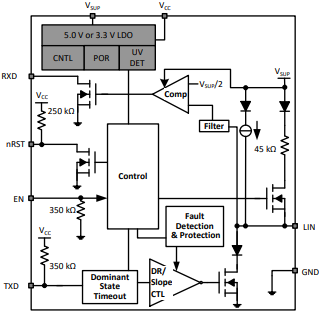TIDUES6 August 2020 – MONTH
- Description
- Resources
- Features
- Applications
- 5
- 1System Description
- 2System Overview
- 3Hardware, Software, Testing Requirements, and Test Results
- 4Design Files
- 5Software Files
- 6Related Documentation
- 7Terminology
2.3.5 TLIN1028-Q1
The TLIN1028-Q1 is a local interconnect network (LIN) physical layer transceiver, compliant to LIN 2.2A ISO/DIS 17987–4.2 standards, with an integrated low dropout (LDO) voltage regulator.
LIN is a single-wire bidirectional bus typically used for low speed in-vehicle networks using data rates up to 20 kbps. The LIN receiver supports data rates up to 100 kbps for end-of-line programming. The TLIN1028-Q1 converts the LIN protocol data stream on the TXD input into a LIN bus signal. The receiver converts the data stream to logic level signals that are sent to the microprocessor through the open-drain RXD pin. The TLIN1028-Q1 reduces system complexity by providing a 3.3-V or 5-V rail with up to 70 mA (D) and 100 mA (DRB) of current to power microprocessors, sensors or other devices. The TLIN1028-Q1 has an optimized current-limited waveshaping driver which reduces electromagnetic emissions (EME).
 Figure 2-6 TLIN10283-Q1 Block Diagram
Figure 2-6 TLIN10283-Q1 Block Diagram